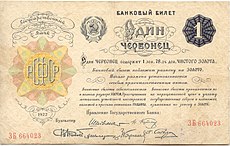자료: http://en.wikipedia.org/wiki/Russian_chervonets
- Chervonets (or tchervonets, Russian: Черво́нец; plural chervontsy) is a former currency of the Russian Empire and Soviet Union.
- Originally a term for coins of purer alloy (the name derives from "червонное золото" meaning pure gold,) the name was later applied to various sums in Russian rubles.
Before the reign of Peter I the name chervonets was applied to various foreign gold coins in circulation in Russia, mostly Dutch ducats and sequins. In 1701 Russia introduced its own gold chervonets, which had the same mass (3.47 g) and alloy (.986) as the ducat. Chervontsy were minted until 1757 when they were displaced by the golden ruble (with a lower alloy) and by counterfeits of the Netherlands ducat, which by then met the demand for trade in gold coins.
In 1922, during the civil war, the Soviet government tried to enforce Communist economic ideals and eliminate debt through systematic devaluation of the rouble and its associated currencies (various forms of Imperial ruble, kerenkas and later sovznaks)[1]
- Meanwhile, the authorities introduced a parallel currency, called chervonets, which was fully convertible and backed by the gold standard. These coins contained 8.6 g. of .900 alloy, and fetched a high rate on the foreign stock exchanges, allowing the financing of the Soviet Union's New Economic Policy.
- Before industrialisation the value of the chervonets was pegged at 10 rubles, and production of the gold coins ceased.[???????... this reader, the writer of this blog]
In 1937, Lenin's portrait first appeared on chervonets banknotes.
- The chervonets was suspended entirely after the monetary reform of 1947.
- A large number of golden chervontsy were restruck to the 1920s design before the 1980 Summer Olympics in Moscow, for the interest of collectors and businesses.
Original gold chervonetz coins were minted in 1923 and 1925. Very few chervonetz coins remain from 1923 and recently been selling for over $7000. There's wide misconception about 1925 issue. All English sources copy each other and say that only 1 gold chervonetz from 1925 survived. It’s not entirely true.
Recent (April 2008) auction in Moscow revealed a huge surprise - a single surviving production sample copper chervonetz from 1925 with slightly modified design from 1923. It now showed the letters SSSR (Russian: СССР) instead of RSFSR (Russian: РСФСР), and introduced new coat of arms (that only featured first 7 republics, by 1939 USSR had 15). This copper sample sold for staggering $200,000 !
There exists five known gold chervonetz from 1925. All are located in Moscow, Russia. Three are stored in the museum of Goznak - Russia's official mint. The other two are located in Pushkin State Museum of Fine Arts.
Here's how the only surviving copper production sample looks like. 1925 Gold Chervonetz looks exactly the same.
http://photos.streamphoto.ru/a/5/f/fa9873f22c4a2b519189ac04d4b89f5a.jpg
Source : http://www.numizmat.net/news/detail.php?ID=9876 (Russian website)
[edit]References
| This article includes a list of references, related reading or external links, but its sources remain unclear because it lacks inline citations. Please improve this article by introducing more precise citations where appropriate. (May 2009) |
- ^ Nenovsky, Nikolay (2006) (PDF). Lenin and the currency competition: reflections on the NEP experience 1922–1924 (ICER Working Paper 22/2006). Turin: International Centre for Economic Research.







댓글 없음:
댓글 쓰기